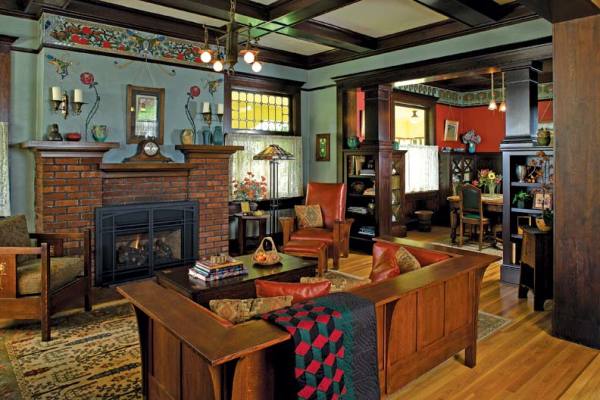
A restored bungalow in Portland, Oregon (embellished with friezes by artist C.J. Hurley), boasts classic A&C seating: a Morris chair and matching ottoman, and an even-arm settle. (Photo: William Wright; furniture photos courtesy of JMW Gallery)
Whether you approach American Arts & Crafts furniture with a design-trained eye or a sentimental heart, its appeal is undeniable. The period’s best pieces stand boldly at the threshold of Modernism. At the same time, the furniture evokes nostalgia for a pre-industrial era. One well-designed piece can be enough to make a statement in a contemporary interior, or you can assemble an entire collection to re-create the warmth of a turn-of-the-century living room.
Although furniture-makers at the dawn of the 20th century produced a wide array of Arts & Crafts-style furnishings, the following pieces have become must-have items for the Arts & Crafts enthusiast. Some forms are easy to find and offer a terrific bang for the buck. Others are what we all aspire to own. Jim Messineo, owner of the JMW Gallery in Boston, offers some advice on pricing and what to look for in a great piece of Arts & Crafts furniture.
Morris Chair
What could be more artsy-craftsy than lounging by the fire with a mug of tea perched on the Morris chair’s wide paddle arm? Introduced around 1865 by Morris & Co., the chair’s adjustable-back design—based on a Sussex carpenter’s pattern—was configured for cozy comfort. Gustav Stickley later took William Morris’ concept and refined the chair’s styling; his slats-to-the-floor design is a now considered an Arts & Crafts classic.
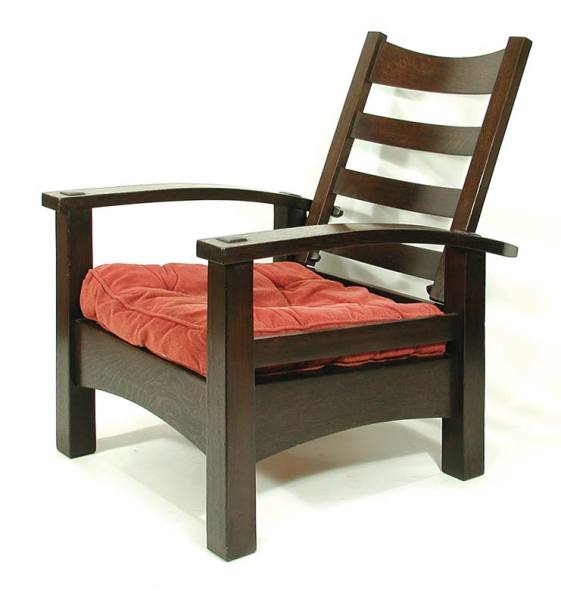
With their turned spindles and claw feet, pre-Stickley-era Morris chairs are usually deemed too fussy by collectors. But even among the pared-down Stickley-designed chairs, there is variety. An open-arm chair (no side slats) is the most affordable, and is still robust and attractive. My early L. & J.G. Stickley open-arm Morris chair has been my husband’s preferred TV viewing seat for more than 15 years. Next in desirability comes the side-slats-to-the-seat model; the aforementioned slats-to-the-floor style is at the top of the desirability scale. From there, even more rarified designs by Stickley can be found, including the bent-arm Morris chair, bow-arm Morris chair, and a design that incorporates slender squared spindles rather than broad slats.
What’s Out There: “If you aspire to a slats-to-the-floor Morris chair, an affordable option is the Morris chair produced by J.M. Young,” advises Messineo. “These can be found in the $2,000 range, whereas a similar Gustav Stickley-designed chair is currently in the $8,000 range.” Good-quality reproductions are also available from Warren Hile Studio and Stickley Audi & Co.
Library Table
This is the perfect accompaniment to a Morris chair, and period examples are relatively plentiful. Library tables are sturdy rectangular tables with a lower shelf on which to pile books. Some have end shelves as well, and generic types are still widely available in antiques shops. People misunderstand the purpose of library tables and assume they are small, uncomfortable desks (“Where do I put my feet with that shelf going across?”), but don’t dismiss them. Find a well-made example (solid oak, through tenons, hefty legs), pile it up with interesting books, and place it away from the wall to make a strong statement in a room.
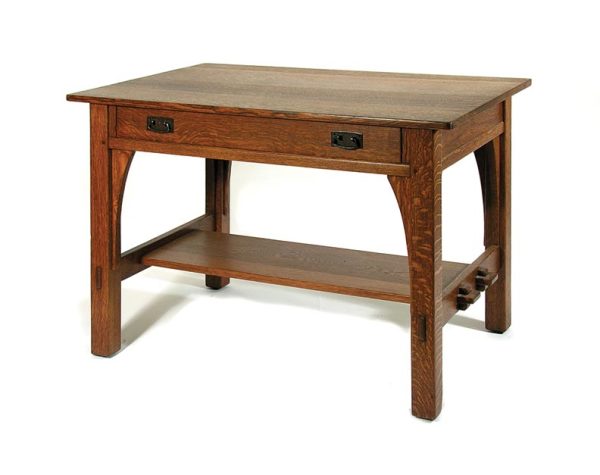
What’s Out There: Period library tables range from $300 to $3,000, depending on quality, maker, and rarity. Library tables from the A&C era were made in large quantities. Unsigned tables that are not quarter-sawn oak, have end shelves, and are nailed together rather than pinned crowd the low end of the price range. Higher-end tables are quarter-sawn oak, and have pegged through tenons and subtle design details, such as corbels on the inner side of the legs.
Even-Arm Settle
Along with the Morris chair, the even-arm settle (also called a box settle) is the quintessential piece of seating for the Arts & Crafts collector. To the uninitiated, the even-arm settle may appear severe and uncomfortable, but the opposite is true if you pile it with comfy cushions and nestle into the corner. Reserve the discomfort rap for those Arts & Crafts settles with high backs and low arms (sort of an indoor park bench). These are better used in entryways or as visual focal points.
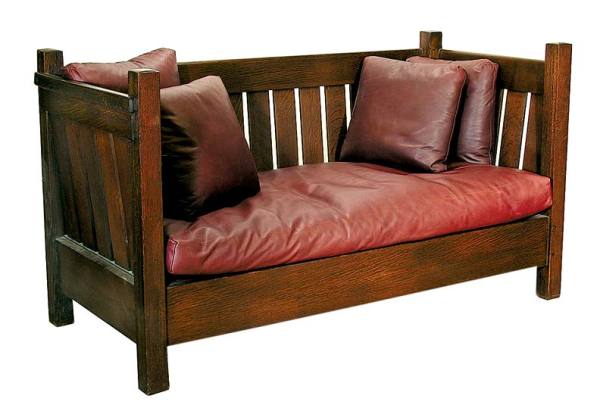
Period examples of box settles can be delightfully light and airy, such as L. & J.G.’s Model #232, with its carefully spaced back slats. Or you may prefer a beefy, deep “crib” settle that envelops the sitter in a sort of room-within-a room.
What’s Out There: Even-arm settles were made by all of the major Arts & Crafts furniture companies and range from $2,000 to $10,000. Higher prices reflect construction, maker, heft, proportion, and comfort, with deeper seats being more comfortable and therefore more desirable.
Tabourets
Perhaps the most beloved piece of furniture of the 20th century and beyond is the highly useful coffee table. Unfortunately, it didn’t exist during the Arts & Crafts period. If you’d like to be true to the period but still have a convenient place to set your glass down, consider a tabouret—a low round or octagonal table. Place a pair of tabourets together in front of your settle for a charming, period-inspired alternative to the ubiquitous coffee table.
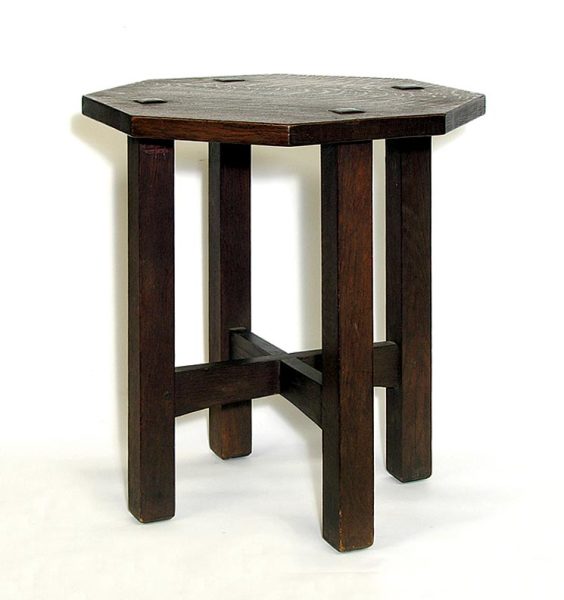
What’s Out There: Tabourets are easily found in antiques stores, for anywhere from $150 to $2,000. They range in quality from turn-of-the-20th-century high-school shop projects to small gems of Arts & Crafts joinery created by Stickley and other fine furniture-makers of the period. The high-end examples have through tenons and gently arched stretchers, and the best have inlaid tiles from period manufacturers like Grueby.
Bookcase or China Cabinet
Storage is a priority for everyone, and there’s no better way to store books or breakables than in a beautiful Arts & Crafts case piece like a bookcase or china cabinet. (The latter has glass sides as well as glass doors to better display china or pottery.) Through tenons on the plank ends are desirable; keyed tenons are even better. Also look for true divided lights on the doors and the use of quarter-sawn oak on the mullions themselves as well as the rest of the piece. Lifetime produced lesser-quality bookcases with a mullion grid laid over a single pane of glass; they are still attractive and desirable, but the price should reflect this cost-cutting production technique.
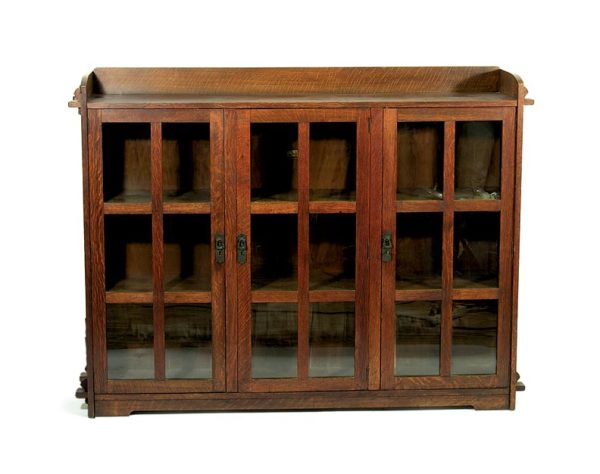
What’s Out There: A bookcase or china cabinet—whether from the period or a reproduction—is an investment. Any high-quality reproduction in solid quarter-sawn oak will still run in the thousands of dollars. All of the period pieces are rare in the marketplace, so any attractive bookcase should be considered. Prices range from $1,000 to $10,000 for antiques, depending on the aforementioned construction details. The low-end pricing includes bookcases with plain glass doors with no mullions. These were produced by all of the Arts & Crafts furniture-makers, and while they don’t have the same look, they do offer an attractive, unobstructed display space for your art pottery collection.
Limbert Occasional Table
Arts & Crafts collectors naturally focus on the Stickleys: Gustav, L. & J.G., and Stickley Bros. But every collector should aspire to a Limbert piece. This Grand Rapids-based manufacturer successfully brought English and Northern European influences into its designs, and Limbert pieces can have interesting cutouts and subtle curves. An exquisite example is the single-oval occasional table, which adds grace to a room with its canted legs, trapezoidal cutouts, and curved top. Place an art pottery vase filled with forced forsythia stems on this table, and your room will become an artistic revelation.
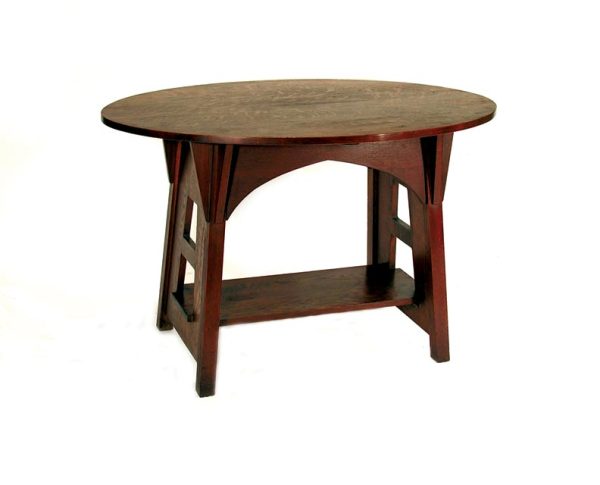
What’s Out There: Expect to pay around $2,000 for a refinished Limbert single-oval occasional table (perhaps subject to too many water stains from flower-filled vases over the years) to $5,000 for one with its original finish. The rare Limbert double-oval occasional table evokes the work of Scottish master Charles Rennie Mackintosh and is in the $10,000 range. Both forms are being reproduced if you can’t wait to locate an original. Stickley Audi calls its single-oval table the Limbert Library Table, and the Warren Hile Studio produces a well-crafted example that would be a beautiful addition to any collection.
Massachusetts-based writer Barbara Rhines is a longtime collector of Arts & Crafts furniture and pottery.







